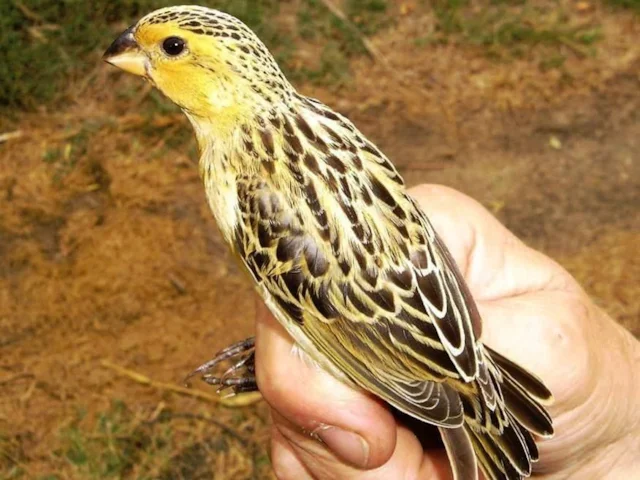Devil in disguise
c020d366-e6fe-4991-ad39-d3c904f47e55

A sub-Saharan African finch species has adopted a unique disguise to help it lay eggs in other birds' nests, biologists have discovered.
It has been shown that female Cuckoo Finch, a brood parasite of other passerine species, has evolved to be almost indistinguishable from female Euplectes weavers, such as the abundant Southern Red Bishop, in a new study which took place in southern Zambia.
Dr William Feeney, from The Australian National University, told Science Daily: "The Cuckoo Finch is so similar to the non-threatening bishops, that the target of the trickery, Tawny-flanked Prinia, cannot tell them apart. The Cuckoo Finch looks a lot more similar to the bishop than its nearest relatives, the Vidua finches or wydah-birds, suggesting that [its plumage] has evolved to be able to hang around prinia nests without arousing suspicion.”
Like cuckoos, the iconic family from which the species gets its name, Cuckoo Finches are obligate brood parasites that lay their eggs in the nests of other birds to deceive them into raising the parasitic young as their own.
Brood parasites use a range of methods to deceive their hosts. The physical mimicry of a different but harmless species (known as 'aggressive mimicry') is used by egg, chick and fledgling brood parasites to appear closely indistinguishable to a host's own eggs, chicks and fledglings. Dr Feeney's research is the first to find that an adult brood parasite (rather than its juveniles or eggs) has evolved to look harmless in an attempt to fool their host.
Dr Feeney added: "This shows that brood parasites use this kind of 'wolf in sheep's clothing' disguise in all stages of their life cycle: as eggs, chicks, fledglings, and – we now know – as adults."
However, the prinia hosts are wising to the attempted deception. Professor Naomi Langmore, Dr Feeney's PhD supervisor at the ANU Research School of Biology, explained: "The prinias have learned to react aggressively towards the innocent female bishops, which look like female Cuckoo Finches.
"They reject foreign eggs from their nest at a higher rate after they have seen either a female Cuckoo Finch or a female bishop. But they do not act the same way if they have seen males of either species, which look quite different."
Reference
Feeney, W E, Troscianko, J, Langmore, N E, Spottiswoode, C N. 2015. Evidence for aggressive mimicry in an adult brood parasitic bird, and generalized defences in its host. Proceedings of the Royal Society B 282: DOI: 10.1098/rspb.2015.0795.
It has been shown that female Cuckoo Finch, a brood parasite of other passerine species, has evolved to be almost indistinguishable from female Euplectes weavers, such as the abundant Southern Red Bishop, in a new study which took place in southern Zambia.
Dr William Feeney, from The Australian National University, told Science Daily: "The Cuckoo Finch is so similar to the non-threatening bishops, that the target of the trickery, Tawny-flanked Prinia, cannot tell them apart. The Cuckoo Finch looks a lot more similar to the bishop than its nearest relatives, the Vidua finches or wydah-birds, suggesting that [its plumage] has evolved to be able to hang around prinia nests without arousing suspicion.”
Like cuckoos, the iconic family from which the species gets its name, Cuckoo Finches are obligate brood parasites that lay their eggs in the nests of other birds to deceive them into raising the parasitic young as their own.
Brood parasites use a range of methods to deceive their hosts. The physical mimicry of a different but harmless species (known as 'aggressive mimicry') is used by egg, chick and fledgling brood parasites to appear closely indistinguishable to a host's own eggs, chicks and fledglings. Dr Feeney's research is the first to find that an adult brood parasite (rather than its juveniles or eggs) has evolved to look harmless in an attempt to fool their host.
 |
| Cuckoo Finch female (left) and female Southern Red Bishop (right); difficult to tell apart by birders and birds alike. Photo: Claire Spottiswoode. |
Dr Feeney added: "This shows that brood parasites use this kind of 'wolf in sheep's clothing' disguise in all stages of their life cycle: as eggs, chicks, fledglings, and – we now know – as adults."
However, the prinia hosts are wising to the attempted deception. Professor Naomi Langmore, Dr Feeney's PhD supervisor at the ANU Research School of Biology, explained: "The prinias have learned to react aggressively towards the innocent female bishops, which look like female Cuckoo Finches.
"They reject foreign eggs from their nest at a higher rate after they have seen either a female Cuckoo Finch or a female bishop. But they do not act the same way if they have seen males of either species, which look quite different."
Reference
Feeney, W E, Troscianko, J, Langmore, N E, Spottiswoode, C N. 2015. Evidence for aggressive mimicry in an adult brood parasitic bird, and generalized defences in its host. Proceedings of the Royal Society B 282: DOI: 10.1098/rspb.2015.0795.

